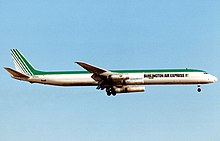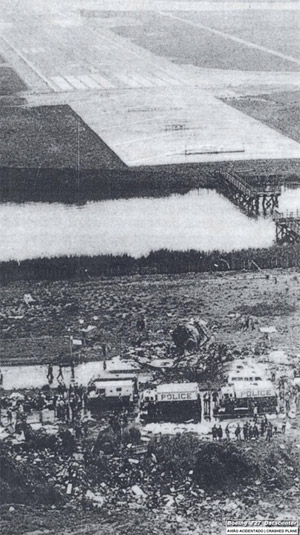
Eastern Air Lines Flight 66 was a regularly scheduled flight from New Orleans to New York City that crashed on June 24, 1975 while on approach to New York's John F. Kennedy International Airport, killing 113 of the 124 people on board. The crash was determined to be caused by wind shear caused by a microburst, but the failure of the airport and the flight crew to recognize the severe weather hazard was also a contributing factor.

American Airlines Flight 96 (AA96/AAL96) was a regular domestic flight operated by American Airlines from Los Angeles to New York via Detroit and Buffalo. On June 12, 1972, the left rear cargo door of the McDonnell Douglas DC-10-10 operating the flight blew open and broke off en route between Detroit and Buffalo above Windsor, Ontario; the accident is thus sometimes referred to as the Windsor incident, although according to the NTSB it is an accident, not an incident.

Surinam Airways Flight 764 was an international scheduled passenger flight from Amsterdam Airport Schiphol in the Netherlands to Paramaribo-Zanderij International Airport in Suriname on a Surinam Airways DC-8-62. On Wednesday 7 June 1989, the flight crashed during approach to Paramaribo-Zanderij, killing 176 of the 187 on board. It is the deadliest aviation disaster in Suriname's history.

Comair Flight 3272 was a Comair flight from Cincinnati to Detroit on Thursday, January 9, 1997. While on approach for landing, the Embraer EMB 120 Brasilia aircraft crashed nose-down 18 miles (29 km) southwest of Detroit Metropolitan Wayne County Airport at 15:54 EST. All 29 aboard, 26 passengers and three crew members, were killed.
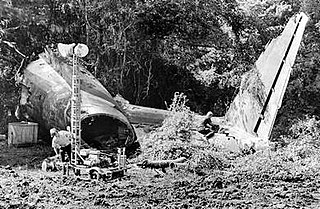
Eastern Air Lines Flight 212 was a controlled flight into terrain accident of a McDonnell Douglas DC-9 during approach to Charlotte Douglas International Airport in North Carolina. The incident occurred on September 11, 1974, killing 72 of the 82 people on board. The scheduled flight was from Charleston Municipal Airport to Chicago O'Hare, with an intermediate stop in Charlotte.

Alaska Airlines Flight 1866 was a regularly scheduled passenger flight operated by Alaska Airlines from Anchorage, Alaska, to Seattle, Washington, with several intermediate stops in southeast Alaska. The aircraft was a Boeing 727-100 with U.S. registry N2969G manufactured in 1966. On September 4, 1971, the aircraft operating the flight crashed into a mountain in Haines Borough, about 18 miles west of Juneau, Alaska, while on approach for landing. All 111 people aboard were killed. The subsequent investigation found that erroneous navigation readouts led the crew to descend prematurely. No definitive cause for the misleading data was found. It was the first fatal jet aircraft crash involving Alaska Airlines, and remained the deadliest single-aircraft accident in United States history until June 24, 1975, when Eastern Air Lines Flight 66 crashed. It is still, however, the worst air disaster in Alaska state history.
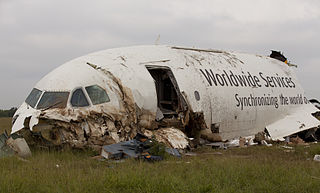
UPS Airlines Flight 1354 (5X1354/UPS1354) was a scheduled cargo flight from Louisville, Kentucky, to Birmingham, Alabama. On August 14, 2013, the Airbus A300 flying the route crashed and burst into flames short of the runway on approach to Birmingham–Shuttlesworth International Airport. Both pilots were pronounced dead at the scene of the crash. They were the only people aboard the aircraft. It was the second fatal air crash for UPS Airlines.

United Airlines Flight 2885 was a scheduled cargo flight from Cleveland to Los Angeles, with stopover in Detroit. On January 11, 1983, a DC-8 operating Flight 2885 crashed after take-off from Detroit, killing all three crew members. The National Transportation Safety Board (NTSB) investigation determined that the cause for the crash was pilot error. A radioactive package was found on board, but no radioactive material was spilled.

Delta Air Lines Flight 723 was a flight operated by a McDonnell Douglas DC-9 twin-engine jetliner, operating as a scheduled domestic passenger flight from Burlington, Vermont to Logan International Airport in Boston, Massachusetts, with an intermediate stop in Manchester, New Hampshire. On July 31, 1973 at 11:08 AM, while on an instrument landing system (ILS) instrument approach into Logan in low clouds and fog, the aircraft descended below the glidepath, struck a seawall and crashed, killing all 89 occupants; two people initially survived, but later died of their injuries.

Trans-Colorado Airlines Flight 2286 was a scheduled domestic passenger flight from Denver, Colorado, to Durango, Colorado, operated for Continental Express by Trans-Colorado Airlines. On January 19, 1988, Flight 2286 crashed onto terrain near Bayfield, Colorado, while on approach to Durango-La Plata County Airport. Out of the seventeen people on board, nine were killed, including both crew members.

Japan Air Lines Cargo Flight 1045 was a charter flight on January 13, 1977, from Grant County, Washington, United States, to Tokyo, Japan, with a stopover in Anchorage, Alaska, United States. The flight crashed during the initial climb phase, shortly after takeoff from Anchorage, in part because the flight captain, Hugh L. Marsh, was intoxicated as shown by a blood alcohol level of 0.29; the co-pilot and the other crew were not impaired. All of those on board, including three flight crew members and two cattle handlers, were killed in the crash.

FedEx Express Flight 1406 was an American domestic cargo flight from Memphis International Airport, Memphis, Tennessee, to Logan International Airport in Boston, Massachusetts, that suffered an in-flight cargo fire over New York on September 5, 1996. The three crew members and two passengers on board successfully evacuated after an emergency landing at Stewart International Airport in Newburgh, New York. After the evacuation, the DC-10 was consumed by fire. After an extensive investigation, the National Transportation Safety Board was unable to determine what caused the fire. Nevertheless, the Federal Aviation Administration made recommendations to prevent similar incidents from occurring in the future.

Emery Worldwide Airlines Flight 17 was a regularly scheduled domestic cargo flight, flying from Reno to Dayton with an intermediate stopover at Rancho Cordova. On February 16, 2000, the DC-8 operating the flight crashed onto an automobile salvage yard shortly after taking off from Sacramento Mather Airport, resulting in the deaths of all three crew members on board. The crew reported control problems during takeoff and attempted unsuccessfully to return to Mather airport.
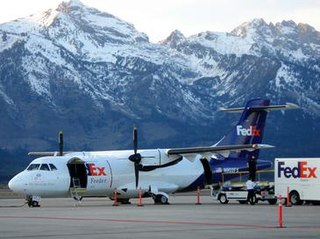
Empire Airlines Flight 8284 was a cargo flight operated by Empire Airlines for FedEx Feeder from Fort Worth Alliance Airport to Lubbock Preston Smith International Airport, Texas. On January 27, 2009, it crashed on final approach to its destination. Both crew members survived with minor injuries but the aircraft was written off.

American International Airways (AIA) Flight 808 was a cargo flight operated by American International Airways that crashed on August 18, 1993 while attempting to land at Leeward Point Field at the Guantánamo Bay Naval Base in Cuba. All 3 crew members on board survived with serious injuries.

Atlas Air Flight 3591 was a scheduled domestic cargo flight under the Amazon Air banner between Miami International Airport and George Bush Intercontinental Airport in Houston. On February 23, 2019, the Boeing 767-375ER(BCF) used for this flight crashed into Trinity Bay during approach into Houston, killing the two crew members and single passenger on board. The accident occurred near Anahuac, Texas, east of Houston, shortly before 12:45 CST (18:45 UTC). This was the first fatal crash of a Boeing 767 freighter.

Ryan International Airlines Flight 590 was a cargo flight carrying mail for the United States Postal Service from Greater Buffalo International Airport (BUF) in Buffalo, New York, to Indianapolis International Airport (IND) in Indiana, with a stopover at Cleveland Hopkins International Airport (CLE) in Cleveland, Ohio. On February 17, 1991, the McDonnell Douglas DC-9-15RC operating the flight crashed on takeoff from Cleveland during icing conditions. Both pilots, the aircraft's only occupants, were killed. The National Transportation Safety Board (NTSB) determined that the causes of the crash were the flight crew failing to deice their aircraft, and the inexperience of the Federal Aviation Administration (FAA), McDonnell Douglas, and Ryan International Airlines with icing condition on DC-9-10 aircraft.

Evergreen International Airlines Flight 17 (4U17/EIA17) was a cargo flight operated by Evergreen International Airlines and flown by a McDonnell Douglas DC-9. On March 18, 1989, the flight's planned route was scheduled to take it from Kelly Air Force Base to Tinker Air Force Base, with a stop at Carswell Air Force Base in Fort Worth, Texas. The two pilots were the only occupants on board. Immediately after takeoff from Carswell, the aircraft's main cargo door opened, the crew lost control of the aircraft and it subsequently crashed while attempting an emergency landing, killing both pilots.

Air Transport International Flight 782 was a ferry flight from Kansas City International Airport in Missouri to Westover Metropolitan Airport in Springfield, Massachusetts using a Douglas DC-8-63 with one of its 4 engines inoperative. On February 16, 1995, the aircraft failed to takeoff from Kansas City, went off the runway, and crashed. All three flight crew members, the only occupants on board, were killed. The cause was deemed to be improper training, which resulted in the crew failing to understand a three-engine takeoff procedure. In addition, the FAA's oversight of rest regulations and the airline were both poor.

CommutAir Flight 4933 was a domestic regional flight operating from Newark, New Jersey, to Presque Isle, Maine, in the United States. The flight was operated by CommutAir under the United Express brand. On March 4, 2019, the Embraer EMB-145XR operating the flight touched down in a snow-covered grassy area to the right of the runway at Presque Isle International Airport, injuring three aircraft occupants and substantially damaging the aircraft. The accident was attributed to confirmation bias which prompted the flight crew to continue descending even though they could not see the runway due to snow; poor decision-making by the captain, fatigue of the first officer, and problems with the airport's instrument landing system were identified as contributing factors.
